1924 GERMANY Weimar Republic HUGO ECKENER of ZEPPELIN Silver Medal NGC i80060
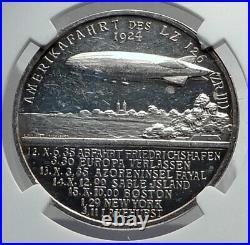
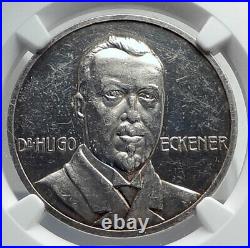
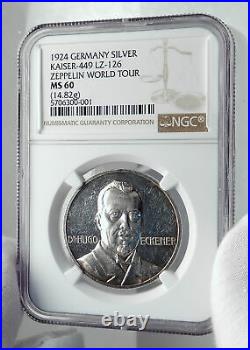
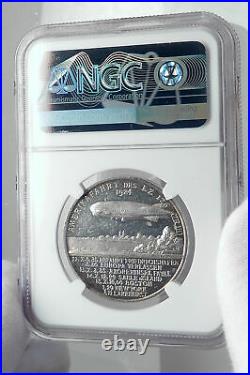
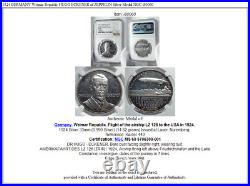

Item: i80060 Authentic Medal of. Flight of the airship LZ 126 to the USA in 1924. 1924 Silver 33mm (0.990 Silver) (14.82 grams) Issued at Lauer, Nuremberg. Reference: Kaiser 449 Certification: NGC.
MS 60 5706300-001 DR HUGO - ECKENER, Bare bust facing slightly right, wearing suit. AMERIKAFAHRT DES LZ 126 (ZR III) / 1924, Airship flying left above Friedrichshafen and the Lake Constance; in exergue, dates of the journey in 7 lines. Hugo Eckener (10 August 1868 - 14 August 1954) was the manager of the Luftschiffbau Zeppelin during the inter-war years, and also the commander of the famous Graf Zeppelin for most of its record-setting flights, including the first airship flight around the world, making him the most successful airship commander in history.
He was also responsible for the construction of the most successful type of airships of all time. An anti-Nazi who was invited to campaign as a moderate in the German presidential elections, he was blacklisted by that regime and eventually sidelined. It was delivered to the United States Navy in October 1924 and after being used mainly for experimental work, particularly in the development of the American parasite fighter program, was decommissioned in 1932. The second of four vessels to carry the name USS Los Angeles , the airship was built for the United States Navy as a replacement for the Zeppelins that had been assigned to the United States as war reparations following World War I, and had been sabotaged by their crews in 1919.
Under the terms of the Treaty of Versailles Luftschiffbau Zeppelin were not permitted to build military airships. In consequence Los Angeles, which had the Zeppelin works number LZ 126, was built as a passenger airship, although the Treaty limitation on the permissible volume was waived, it being agreed that a craft of a size equal to the largest Zeppelin constructed during World War I was permissible. The airship's hull had 24-sided transverse ring frames for most of its length, changing to an octagonal section at the tail surfaces, and the hull had an internal keel which provided an internal walkway and also contained the accommodation for the crew when off duty. Following the precedent set by LZ 120 Bodensee, crew and passenger accommodation was in a compartment near the front of the airship that was integrated into the hull structure.All drove two-bladed pusher propellers and were capable of running in reverse. Auxiliary power was provided by wind-driven dynamos.
The airship was commissioned into the US Navy on 25 November 1924 at Anacostia, D. On its arrival in the United States, its lifting gas was changed from hydrogen to helium, which reduced payload but improved safety. At the same time the airship was fitted with equipment to recover water from the exhaust gases for use as ballast to compensate for the loss of weight as fuel was consumed, so avoiding the necessity to vent scarce helium to maintain neutral buoyancy. The airship went on to log a total of 4,398 hours of flight, covering a distance of 172,400 nautical miles (319,300 km). Long-distance flights included return flights to Panama, Costa Rica and Bermuda.On 25 August 1927, while the Los Angeles was tethered at the Lakehurst high mast, a gust of wind caught her tail and lifted it into colder, denser air that was just above the airship. This caused the tail to lift higher. In 1929, the Los Angeles was used to test the trapeze system developed by the US Navy to launch and recover fixed wing aircraft from rigid airships. The tests were a success and the later purpose-built Akron -class airships were fitted with this system. The temporary system was removed from the Los Angeles, which never carried any aircraft on operational flights.
On 31 January 1930, the Los Angeles also tested the launching of a glider over Lakehurst, New Jersey. On 25 May 1932, the Los Angeles participated in a demonstration of photophone technology.As the terms under which the Allies permitted the United States to have the Los Angeles restricted its use to commercial and experimental purposes only, when the U. Navy wanted to use the airship in a fleet problem in 1931 permission had to be obtained from the Allied Control Commission. The Los Angeles took part in Fleet Problems XII (1931) and XIII (1932), although as was the case with all U. Navy rigid airships, demonstrated no particular benefit to the fleet.
The Los Angeles was decommissioned in 1932 as an economy measure, but was recommissioned after the crash of the USS Akron in April, 1933. She flew for a few more years and then retired to her Lakehurst hanger where she remained until 1939, when the airship was struck off the Navy list and was dismantled in her hangar. The Los Angeles was the Navy's longest serving rigid airship. Unlike the Shenandoah, Akron, and Macon, the German-built Los Angeles' was the only Navy rigid airship which did not meet a disastrous end.World-renowned expert numismatist, enthusiast, author and dealer in authentic ancient Greek, ancient Roman, ancient Byzantine, world coins & more. Ilya Zlobin is an independent individual who has a passion for coin collecting, research and understanding the importance of the historical context and significance all coins and objects represent. Send me a message about this and I can update your invoice should you want this method. Getting your order to you, quickly and securely is a top priority and is taken seriously here. Great care is taken in packaging and mailing every item securely and quickly.
What is a certificate of authenticity and what guarantees do you give that the item is authentic? You will be very happy with what you get with the COA; a professional presentation of the coin, with all of the relevant information and a picture of the coin you saw in the listing. Additionally, the coin is inside it's own protective coin flip (holder), with a 2x2 inch description of the coin matching the individual number on the COA. Whether your goal is to collect or give the item as a gift, coins presented like this could be more prized and valued higher than items that were not given such care and attention to. When should I leave feedback?
Please don't leave any negative feedbacks, as it happens sometimes that people rush to leave feedback before letting sufficient time for their order to arrive. The matter of fact is that any issues can be resolved, as reputation is most important to me. My goal is to provide superior products and quality of service. How and where do I learn more about collecting ancient coins?
Visit the Guide on How to Use My Store. For on an overview about using my store, with additional information and links to all other parts of my store which may include educational information on topics you are looking for.This item is in the category "Coins & Paper Money\Exonumia\Medals". The seller is "highrating_lowprice" and is located in this country: US. This item can be shipped worldwide.
- Country/Region of Manufacture: Germany
- Denomination: Denomination_in_description
- Year: Year_in_description
